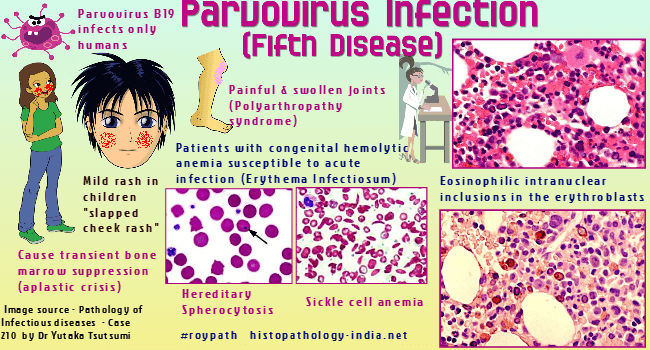Contents
Parvovirus B19: symptoms and treatments
Commonly known as fifth disease, epidemic megalerythema, or erythema infectiosum, is a viral infection caused by human parvovirus B19, a virus that only affects humans. Usually mild, it contracts in the same way as the common cold virus. It is characterized by the appearance of rashes, flu-like symptoms and joint pain. The aim of the treatment is to relieve the symptoms.
What is parvovirus B19 infection?
Epidemic megalerythema, or erythema infectiosum, is a viral infection caused by human parvovirus B19. This contagious infection, usually mild, occurs more frequently in late winter and early spring, often as geographically limited epidemics, among very young children, especially those aged 5 to 7 years. Although 70% of cases occur in children aged 5 to 15 years, parvovirus B19 infection can also affect younger children and adults. Present all over the world, it is more often observed in temperate countries. It seems more common among girls.
Parvovirus B19 infection is often referred to as fifth disease, as it was the fifth infectious childhood disease characterized by a rash to be given a name.
What are the causes of parvovirus B19 infection?
Parvovirus B19 has been successively called SPLV for Serum Parvovirus-Like Virus, HPV for Human Parvovirus and B19 with the initials identifying the blood bag where it was first identified. It is a virus that only affects humans.
Parvovirus B19 infection can be transmitted by the respiratory route. It is contracted the same way as the common cold virus, by:
- putting their fingers to their mouth after touching an infected person;
- putting his fingers to his mouth after touching an object contaminated by an infected person;
- inhaling small droplets containing virus particles released into the air by an infected person when they cough or sneeze.
The infection tends to spread within the same focus. During an epidemic, non-immune contact subjects become infected in 50% of cases.
Parvovirus B19 infection can also be transmitted from mother to fetus during pregnancy, through the placenta, which can lead to late fetal death or severe fetal anemia with generalized edema (hydrops fetalis). However, almost half of pregnant women are immune from a previous infection.
Finally, this infection can also be transmitted through the blood, in particular through blood transfusions.
What are the symptoms of parvovirus B19 infection?
The signs and symptoms of parvovirus B19 infection usually appear 4 to 14 days after getting it, sometimes longer.
The first symptoms of fifth disease are often confused with those of other infectious diseases such as the common cold. They understand :
- low fever;
- headaches ;
- nasal congestion;
- a runny nose;
- stomach aches.
Several days later, a rash appears mottled or consists of raised red papules or redness of the cheeks. The rash can spread to the arms, trunk, and then to the rest of the body, usually excluding the soles of the feet and the palms of the hands. The rash occurs in 75% of children and 50% of adults. It is itchy and is characterized by red patches with jagged edges that resemble lace, which are aggravated by exposure to sunlight.
Anyone infected with parvovirus B19 is contagious for a few days before this characteristic rash appears. The contagion period ends as soon as it is visible.
The intensity of symptoms varies from person to person. In 50% of cases, the infection goes unnoticed or is mistaken for a cold. Usually mild, it can be more serious in some people, including:
- children with anemia or sickle cell anemia;
- people with diseases, such as AIDS, which impair the ability of the immune system to fight infections;
- the adults ;
- pregnant women.
In children with anemia, sickle cell anemia, or diseases that weaken the immune system, parvovirus B19 can affect the bone marrow and cause severe anemia.
In adults, swelling and mild joint pain (non-erosive arthritis) appear in 70% of cases. These joint manifestations are particularly common in women. The hands, wrists, ankles and knees are the most affected. These pains go away in 2 or 3 weeks, but can persist or recur for weeks or even months or years.
In pregnant women, the primary infection can be responsible in 10% of cases for:
- spontaneous abortion;
- fetal death;
- hydrops foeto-placental (excessive accumulation of amniotic fluid in the fetal extravascular compartment and cavities) which mostly occurs during the 2nd trimester of pregnancy;
- severe anemia;
- fetal hydrops (fetal edema).
The risk of fetal death is 2-6% after maternal infection, with the highest risk during the first half of pregnancy.
The rash and the entire illness usually last 5-10 days. Over the next few weeks, the rash may reappear temporarily after exposure to the sun or heat, or with fever, exertion, or emotional stress. In adolescents, mild joint pain and swelling may persist or recur intermittently for weeks or even months.
How to cure parvovirus B19 infection?
There is no vaccine against parvovirus B19. However, once a person has been infected with this virus, they are immune to future infections for life.
There is also no specific treatment for parvovirus B19 infection. The aim of the treatment is to relieve the symptoms.
Relief from fever, headache and joint pain
Recommended treatment:
- paracetamol ;
- nonsteroidal anti-inflammatory drugs (NSAIDs) such as ibuprofen.
Relief from itching if severe
Recommended solutions:
- cold compresses;
- colloidal oatmeal powder to add to bath water;
- creams or lotions.
Other recommendations
It is also advisable to:
- drink abundantly;
- wear light, soft clothing;
- avoid rough fabrics;
- promote rest;
- avoid excessive heat or exposure to the sun, which can cause worsening or recurrence of skin rashes;
- keep children’s fingernails short and clean or even have them wear gloves at night to prevent scratching.










